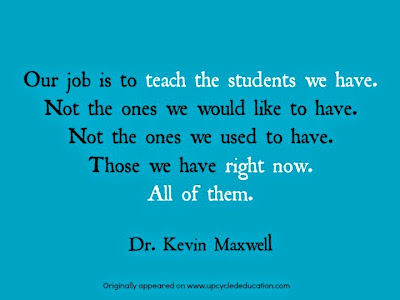Learning for All is based on three core elements:
—Personalization - getting to know your students
—Precision - Assessment the driving force behind the IEP
—Professional Learning
“The glue that binds these 3 components is moral purpose: education for all that raises the bar as it closes the gap.”
- Fullan, Hill & Crevola, 2006
Do you believe that Every Child Can Succeed?

“Every child can learn
Just not on the same day
Or the same way”
George Evans
Discussion: Do you believe in the following guiding principles?
1. All students can succeed.
2. Each student has his or her own unique patterns of learning.
3.Successful instructional practices are founded on evidence-based research, tempered by experience.
4.Universal Design and DI are effective interconnected means of meeting the learning and productivity needs of any group of students.
5.Classroom teachers are the key educators for a student’s literacy
and numeracy development.
and numeracy development.
6.Classroom teachers need the support of the larger community
to create a learning environment that supports all students
to create a learning environment that supports all students
7.Fairness is not sameness: For equitable outcomes some students require: “More or different support than others to work at a level appropriate to their abilities and needs.”
What does this diagram mean to you?
 (Learning For All, p.9)
(Learning For All, p.9)
Reaching Every Student begins with knowing your students. The following steps are part of the process of of getting to know all the students in the class"
- Gather information about the students
- Engage students and Parents in the information gathering
- Process and synthesize the information
- Select, develop assessment and instructional strategies that address the learning needs of the students in the class
Always Start with the Student
When we believe that it is our students who are the starting point for our unit and lesson planning, not the the course content or textbook, we try to live that belief by getting to know students' learning needs and preferences and respond accordingly. p.34
Two effective tools to use:
- Class profile
- Individual student profile
Class Profile Template:
This is living document that can be updated all year long. The benefits of a class profile besides a better understanding of the learners in your classroom it is also a valuable tool to use when differentiating and personalizing instruction, devising effective assessment and evaluation practices, and helping develop students' understanding and use of metacognition.
(Learning For All, p.39)

(Learning For All, Appendix A)
The process for develoiping an individual student profile can be found on page 48 of Learning For All
We found it important to have information from each category below which we turned into a chart that can be filled out prior to an in school team meeting.
Use the chart below to collect information about a student or create a student profile prior to a meeting to discuss next steps.
Principal in the Know - Find the answer to the question by following the link
The Question:
“Learning for All, K-12 (2013), an important resource for
instructional leadership practice, describes an integrated
process of assessment and instruction that supports
personalized and precise teaching and learning for all
students, including students with special education needs,
from Kindergarten to Grade 12. How can I use this
document to support the professional learning of all
educators in my school?”
http://www.edu.gov.on.ca/eng/policyfunding/leadership/pdfs/issue26.pdf
http://www.edu.gov.on.ca/eng/policyfunding/leadership/pdfs/issue26.pdf
Resources:
Inquiry into Practice: Reaching Every Student Through Inclusive Curriculum, UofT
https://www.oise.utoronto.ca/oise/UserFiles/File/ITE_PUB_2011_COMPLETE_LR1.pdf
Reach every student through Differentiated Instruction
http://www.edugains.ca/resourcesDI/Brochures/DIBrochureOct08.pdf
Reach every student through Differentiated Instruction
http://www.edugains.ca/resourcesDI/Brochures/DIBrochureOct08.pdf

